
MARCH OF THE TITANS - A HISTORY OF THE WHITE RACE
CHAPTER 8 : EGYPT - GREAT PHARAOHS AND LOWLY SLAVES
The Neolithic (farming) revolution had reached Egypt by the year 5000 BC and, typically for the time, the Neolithic settlements in Egypt were independent of one another. Archaeological finds on these sites of items such as copper ore, lead and silver, show that they had established definite contact with the civilization in Mesopotamia. This period in Egypt of loose settlement is called the pre-dynastic period and is formally considered to have come an end in 3100 BC.
"GINGER" AND OTHER INHABITANTS OF EARLY EGYPT
Racially speaking, the inhabitants of Egypt at this period in time were divided into three groups. Skeletal evidence from grave sites show that the original White Mediterraneans and Proto-Nordics were in a majority in the area - a well preserved body found in a sand grave in Egypt dating from approximately 3000 BC, on display in the British Museum in London, has even been nicknamed "Ginger" because of his red hair - a racial trait only found in persons of Nordic ancestry.

Above: Entering Egypt at the time of the great Indo-European migrations from the Black Sea Basin circa 5600 BC, Nordic peoples such as "Ginger" (below) settled the Nile River Valley and laid the basis for what was, by 3000 BC, to become the first Egyptian Dynasty.
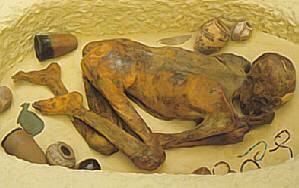
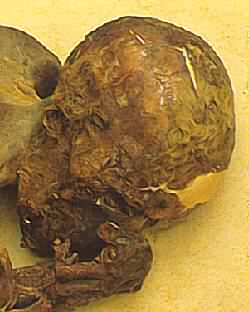
A well preserved body from the pre-dynastic period in Egypt, circa 3,300 BC. Buried in a sand grave, the natural dryness of the surroundings kept the body preserved. His red hair (and thus Nordic features) have been so well preserved that he has been given the nickname "Ginger" at the British Museum where he is kept on public display. Right: "Ginger's" head.
However, diggings also reveal a significant minority of Semitic (Arabic) peoples were living in the Nile Delta valley alongside the Whites, and in the very far south (in what later became southern Egypt and the Sudan) lived a large number of Blacks. These were the Nubians who were to feature in Egypt's history - and against whom the Egyptians waged war and enslaved for nearly 2,000 years.
The existence of these two Nonwhite groupings within Egypt was later to have a major impact on the history of that civilization, and also do much to destroy the "environmental" theory of the origin of civilizations, as all three groups shared the same environment, yet produced very different levels of achievement.
THE OLD KINGDOM 3100 - 2270 BC
In terms of contemporary time frames, however, the Egyptian state first started formally emerging shortly after the establishment of the civilization between the Tigris and Euphrates river valley.
By the year 3100 BC, a measure of unity had started to take hold in Egypt, coalescing into northern and southern kingdoms. Around that year a dynamic leader named Menes united these northern and southern kingdoms and established a capital city at Memphis on the Nile River. The year 3100 BC therefore marks the start of the Dynastic Period, called the Old Kingdom by historians.
Menes developed the idea of using channels to divert the waters of the Nile to irrigate land - and this irrigation system exists along the Nile River to this day. Menes was such a gifted and charismatic leader that he was later deified by later Egyptians, and a cult developed which pictured him as a direct descendant of the Gods, a tradition which then spread to other pharaohs. It is very likely that the very word "man" originated with Menes.
During the reign of Menes, construction was first started on the greatest city of ancient Egypt, Memphis, which became the capital of this first kingdom. Also about this time, Egyptian pictograph writing appeared, probably inspired by the Sumerian script. The Old Kingdom traded extensively with surrounding lands, obtaining wood from Lebanon and copper from mines in the Sinai peninsula.
It was also during this Old Kingdom period that the great pyramids and Sphinx at Giza were built, starting around the year 2,500 BC. The project was launched by Pharaoh Cheops (also known as Khufu), who, because of the pyramids, remains one of the most famous pharaohs of this First Kingdom.
The Cheops pyramids are however not the oldest Egyptian pyramids - the step pyramid at Memphis predates the Cheops pyramids by at least a century, and was designed by a court architect who was later to be deified by the Egyptians, Imhotep. This great structure, nearly 66 meters high, must have seemed overwhelming to ordinary Egyptians at the time, who at best lived in two story mud brick houses, and it is no surprise that the builder was eventually deified.
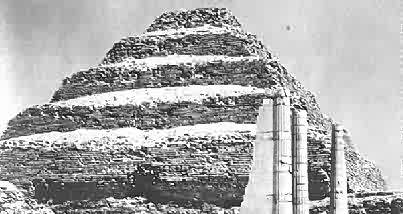

Left: The first great pyramid of Egypt: the step pyramid of Saqara, circa 2600 BC. The architect, Imhotep, was later made into a deity out of respect for this technological achievement. Right: The Sphinx and pyramids of Giza, circa 2500 BC.
The Cheops pyramids are impressive today - by the standards of the time of their construction they must also have appeared to be superhuman. Twenty years in the building, these pyramids used between five and six millions tons of stone, some blocks being moved over 500 miles, with virtually perfect masonry work on site so that the alignment variance of the stones even today is less than one percent. The greatest pyramid reaches 146 meters - higher than St. Peter's cathedral in Rome (which remains the biggest Christian cathedral in the world.)
RELIGION
Charms and magical prayers were collected into a book and paid for by the living to put into their tombs - a sort of insurance policy for a successful resurrection in the hereafter. This book made up what is known as the "Egyptian Book of the Dead."
Egyptian religion of the time was primarily concerned with the achievement of life after death. The practice of mummification was started on the basis of a myth that the God of the Nile River, Osiris, had been murdered by his evil brother, Seth. According to the myth, Seth cut Osiris' body into pieces. These pieces were however gathered together by Osiris' grieving widow, Isis, and re-assembled, thus resurrecting Osiris.
The Nile God then became the first mummy, and every mummified Egyptian became a second Osiris. This resurrection theme was to become dominant in other religions, and adopted by Christianity.
Thus the tradition of mummification started: a jump start to everlasting life in the hereafter. The process of mummification has also provided modern day historians with a spectacular and virtually unique chance to see the physical characteristics of Egyptians exactly as they were. The evidence is overwhelming that these first Egyptian societies were White - a Proto-Nordic/Alpine/Mediterranean cross. The leadership elite - in particular the pharaohs themselves - were mostly Nordic.
The mummified remains of numerous pharaohs and common folk from this first great Egyptian civilization have unmistakable White features, while the first written reference to blond hair is made on an Egyptian wall painting of the daughter of the famous pharaoh Cheops, Queen Hetep-Heres II, who is identified specifically by her blond hair.
The well preserved body of Pharaoh Ramses II has red hair, and there are large numbers of mummies whose blond hair has been extraordinarily well preserved through the centuries. This tradition of Nordic pharaohs was to last almost till the second part of the Third Kingdom, circa 1050 BC, by when racial demographic shifts had taken place in Egyptian society in favor of Nonwhite groups.


Nordic nobility in Ancient Egypt: Left: Yuya, Egyptian nobleman from 1400 BC, father of Tiy, the wife of Pharaoh Amenhotep III. Yuya's blond hair and Nordic facial structure have been well preserved by the embalming process; Right, a Nordic Egyptian Female Pharaoh: Queen Hatshepsut, wife of Pharaoh Thutmosis II. She ruled Egypt after Thutmosis' death in 1520 BC. Her long blonde hair and Nordic facial structure has been well preserved by the embalming process of the time.

Nordic Egyptian King: the mummy of Pharaoh Seti I is the most lifelike of the great pharaohs of Egypt, and a tribute to the embalmer's art. His Nordic features remain crystal clear and because of the excellent preservation process, Seti's mummy can easily be compared with a relief of his face made in his lifetime at the Temple at Abydos. Seti was the son of the great Ramses I, and became pharaoh in 1320 BC. He reoccupied lands in Syria lost to earlier Syrian invasions, conquered Palestine and conducted campaigns against the Semitic Libyans and the Indo-European Hittites.
RACIAL IMAGES IN EGYPTIAN ART
Egyptian art is also filled with racial images: slaves and enemies of Egypt are almost always depicted as Semites or Blacks (with one or two Nordic slaves thrown in - they are easily identified by not only their facial features but also by their depiction with blond hair). These slaves were probably captives from wondering Indo-European invaders who had the misfortune to fall into bondage in Egypt.

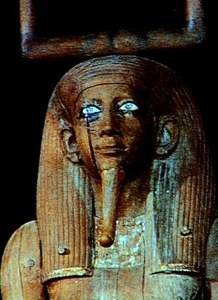
An original wooden statue of the Egyptian King Hor (circa 1783 - 1633 BC) is inlaid with striking blue eyes. (On display at the Cairo Museum, Cairo, Egypt). Left: a general view of the statue; and right: a close-up of the face showing the Nordic eye coloring.
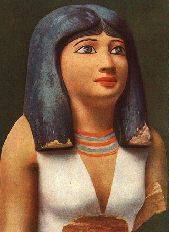
A blue eyed statue from the earliest Egyptian dynasties: A bust of an Egyptian noble lady from the fourth dynasty - around 2800 BC. A strikingly lifelike figure, inlaid with lapus lazuli blue eyes, it was placed inside the lady's tomb.
All this is not to say that no other races lived in the area. There lived a significant number of Semitic Arabic racial types, who had settled there from their homeland in the Arabian peninsula.
These Nonwhite peoples were however for many years - centuries even - excluded from mainstream Egyptian society because of their race, being most often used as laborers, along with Blacks captured by the Egyptians in warring expeditions even further south into modern day Sudan.

Semites, clearly identified as racially foreign with distinctive "Jewish" noses, present tributes to the Egyptian pharaoh, a painted scene from the tomb of Sobkhotep at Thebes.

Egyptian scribe from Saqara, circa 2,600 BC. An excellent Mediterranean sub-racial type depicted in an original Egyptian sculpture.
EGYPTIAN ACHIEVEMENTS
Aside from the stupendous achievement of building the pyramids, the White civilization of Egypt is credited with many achievements, some of which benefit to this day. The Egyptians were the first to divide the solar year into 365 and one quarter days and twelve months, each of three weeks of ten days long, with five extra days at the end of the year.
The Egyptians also became famous for their medical skills, although the difference between magic and science does nor appear to have been fully made. Evidence exists of advanced surgery having been carried out as far back as the First Kingdom, and many techniques and herbal remedies were taken over in toto by the Classical Greeks and survived right into medieval European times.
In contrast to Mesopotamian writing, Egyptian writing (hieroglyphics, meaning "sacred signs") remained pictorial in content throughout the span of this civilization. Egyptian writing was only deciphered in 1822 after the discovery of the Rosetta Stone.
THE MIDDLE KINGDOM (THE SECOND KINGDOM) 2060-1785 BC
The period 2270 - 2060 BC was marked by great instability in Egypt, where the political unity of the country fell to pieces for the lack of a strong leader. Only in the year 2060 BC was Egypt again politically united and once again rose to its old Kingdom splendor, although never again managing to build anything of the size of the Great Pyramids of Giza.
This period of political unity did not however last longer than 70 years, and around the year 1785 BC, a divided Egypt was conquered by a Semitic tribe known as the Hyksos, who had little trouble subjecting the Egyptians, aided through the use of iron weapons and a new fearsome weapon - the horse and chariot, neither of which the Egyptians had seen before. The Hyksos themselves had been attacked with this weapon by the Indo-European Nordic tribes who had developed this weapon on their route south from their respective homelands in the north.
It took some 200 years for the Egyptians to rebuild their strength and the Hyksos were only eventually expelled in 1580 BC - after the Egyptians had managed to master the new weapon of horse and chariot and turn it against the Hyksos.
The Egyptian records show that the Minoans from Crete had helped to fight the Semitic Hyksos invaders - further evidence of the close links between the Egyptians and the old European civilization.
However, the result of 200 years of Hyksos rule left its mark upon the Egyptian population, and a small but from then on growing number of the original White populace began to show physical characteristics which mark the start of the dissolution of the White gene pool into the White/Semitic mix which came to characterize virtually the entire Middle and Near East.
However, the majority of the Egyptian population was still overwhelmingly original White at this stage - it was only with the Third kingdom and its expansion into areas heavily populated by Nubians (Blacks from Sudan) and Ethiopia (occupied by masses of Arab/Semitic peoples) that large numbers of these Nonwhite peoples came to be prominent in Egyptian society, either as slaves or freemen.
THE NEW KINGDOM (THE THIRD KINGDOM) 1580-1085 BC
The third (and last) great surge in Egyptian power came with the expulsions of the Semitic Hyksos. Adopting the horse and chariot, energetic and expansionist pharaohs set about consolidating Egypt and establishing an empire. Syria, Phoenicia, Palestine, Nubia and northern Sudan (the latter with large Black populations) were all conquered and incorporated into the Egyptian empire.
The greatest expansionist king was Thutmose III (1501 - 1447 BC) and a series of tall pointed stone columns (called obelisks) were built to commemorate his various campaigns. Only four of the obelisks survived the ages and strife of Egypt's history, and today they stand in Istanbul, Rome, London and New York, silent reminders of the greatness of a bygone age.
The greatest pharaoh of this time was Amenhotep III (1411 - 1375 BC) who built Thebes up into the world's most magnificent city of the time. Amenhotep built many other huge structures, including the temple of Luxor at the city of Thebes
TUTANKHAMEN
Tutankhamen, the boy king (who died when he was 18) reigned around 1350 BC. Although he died too young to become a pharaoh of any great significance in his own time, he gained fame when his tomb was discovered virtually intact in 1924 (one of the few tombs to be found in such a good state - most had been the subject of grave robbers centuries before). It is the gold burial mask of Tutankhamen which has come to symbolize ancient Egypt.
However, the real significance of the finds in Tutankhamen's tombs have been largely ignored: amongst Tutankhamen's possessions are some of the most graphically racial images in Egyptology.
One of Tutankhamen's thrones, the ecclesiastical chair, has on its' footstool the "Nine Bows" - the Egyptian name for the traditional enemies of Egypt. The finely crafted figures on the footstool are of nine Blacks and Semites tied together in chains. Their positioning on the footstool was so that when the pharaoh sat on his throne, his enemies would be under his feet.
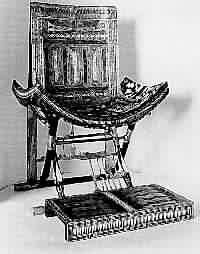
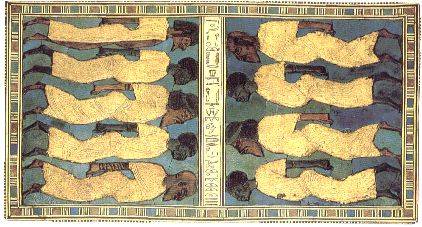
Racial imagery from Tutankhamen's tomb: the ecclesiastical throne, shown assembled, and a full view of the footrest. Bound Semitic and Black prisoners appear on the footstool: the Egyptian king would rest his feet on his foes.
Another graphically racial image found in Tutankhamen's tomb is to be found on one of his walking sticks. The handle is made up of a bound Semite and a bound Black: so that when the Egyptian king went for a walk with his royal walking stick, he held the enemies of Egypt in his hand.

Racial imagery from Tutankhamen's tomb: bound Semitic and Black prisoners decorating the curved end of Tutankhamen's walking stick: when the Egyptian king went for a walk, he would hold the enemies of Egypt in his palm.
Yet another candid racial image from Tutankhamen's tomb is to be found in a pair of his sandals. Inlaid with a picture of a Semite and a Black, the pharaoh would trample his enemies underfoot when he walked.
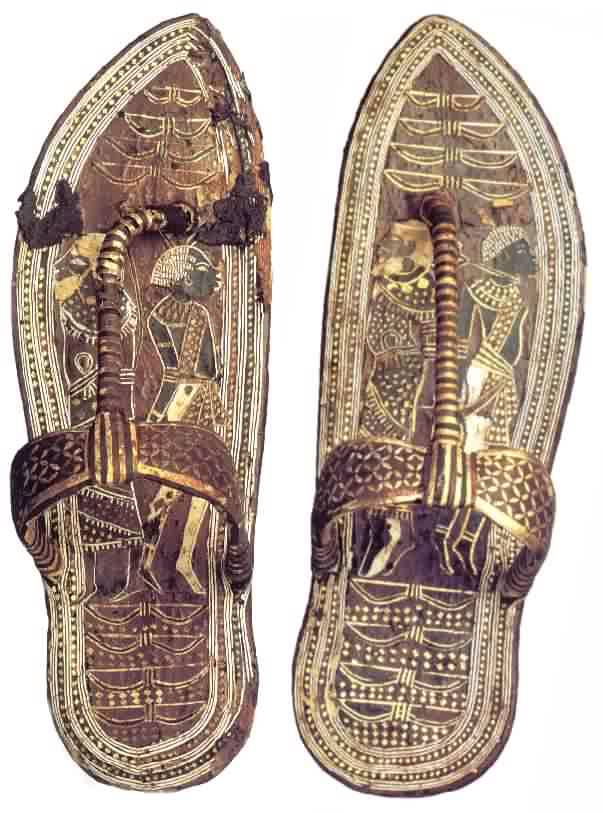
Racial imagery from Tutankhamen's tomb: the Egyptian king's sandals have bound Black and Semitic prisoners inlaid into the soles: when the king walked in these shoes, he would crush the enemies of Egypt underfoot.
Tutankhamen's famous wooden chest, which was found in the ante-chamber of his tomb, contains yet another striking scene. On its sides, it shows the Egyptian King riding a chariot and trampling the "Nine Bows" or enemies of Egypt: Blacks and Semites.
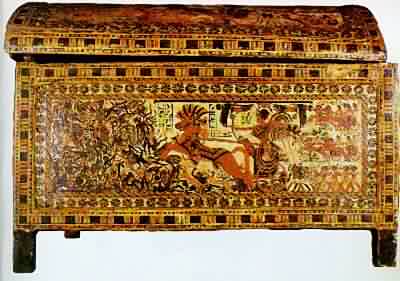
A general view of the wooden chest (above) and below, a detail from the side, showing Tutankhamen trampling Blacks and scattered Semites under the wheels of his chariot and under his horses' hooves. Note also the three Black slaves fanning Tutankhamen at the rear of his chariot - the use of Nonwhite labor being the primary reason why that civilization was eventually overrun by the Nonwhites.
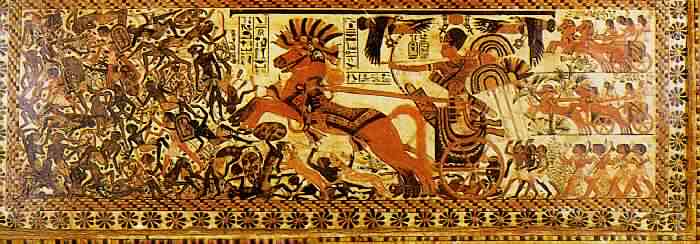
By Tutankhamen's time then, the Egyptians were clearly aware of the growing numbers of their racial enemies creeping up on them.
These graphic and stunning references to clearly identifiable racial enemies of Egypt are all the more remarkable when it is born in mind that the population make-up of Egypt had, by the reign of Tutankhamen, already started to swing heavily against the original White Egyptians, with Black and Semitic slaves being commonplace within that civilization.
In addition to this, a significant number of Egyptians themselves were now of mixed race, the Hyksos occupation having left behind a number of Egyptian/Semitic mixes. Significantly, Tutankhamen's widow attempted to strike an alliance with the Indo-European Hittites who had in the interim became the leading power in the Near East, by arranging her marriage to a Hittite prince. (The marriage never took place, as the husband to be was killed just prior to the ceremony).
SEA PEOPLES
From the time of Tutankhamen onwards, the final decline of Egypt was irreversible. Later kings tried to reverse the trend - sometimes they succeeded, temporarily, in rolling back the waves of conquest and counter conquest in Palestine and Syria, and at one time a pharaoh did manage to take a Hittite princess as a bride.
But there were new enemies: Egypt was now attacked by new Indo-European invaders emerging from the Aegean, the so called Sea peoples. As their name implied, they arrived by boat and raided Egyptian settlements, leaving again by the means which they arrived.
These Sea Peoples were mainly comprised of Philistines from Asia Minor and Aecheans from mainland Greece.
Egyptian illustrations of the time show prisoners being taken with light hair and light eyes - Sea People raiders unfortunate enough to fall into captivity in Egypt, where they could expect no mercy.
THE DISAPPEARANCE OF THE WHITE EGYPTIANS
Ever since the time of the Hyksos invasion and the fall of the Second Kingdom, the demographic shift amongst the Egyptian population had been against the original Whites. Slowly at first, but then speeding up, Nonwhites or mixed racial types began to make up more and more of that country's population - drawn in as slaves, laborers, immigrants or invaders.
These other racial types were of two sorts: Semites (whom the Egyptians called "Sand Dwellers") and Blacks, from region of Nubia in the far south (present day Sudan).
A review of Egypt's relations with Nubia is therefore crucial to understanding what happened to the White Egyptians, and why they vanished.
RACE WAR WITH NUBIA
Clashes between the Egyptians and the Black Nubians had long been a feature of Egyptian history, with the first campaigns against the Nubians being launched by Old Kingdom pharaohs around 2900 BC. In 2570 BC, Pharaoh Sneferu launched a concerted attack upon Nubia. Egyptian records show that 70,000 prisoners were taken, a figure which must have been a staggering amount at the time. In 1296 BC Egypt conquered Nubia and built a series of massive forts to protect Egypt's southern borders against the Nubians, with the most famous of these being the fort at Buhen, which had walls which were 111 meters high and 4.5 meters thick.
Along the banks of the southern Nile huge stones were erected upon which, in hieroglyphics still visible today, the passage of Blacks past those points was forbidden - the first public "Whites Only" signs in history.
At the time of the Hyksos invasion of Egypt, many local Nubian kings allied themselves with the Hyksos and inflicted defeats upon the weakened Egyptians, including the destruction of the southern forts.
When the Hyksos were finally driven out, the White Egyptians exacted a terrible revenge upon the Blacks, launching many campaigns of conquest and suppression against them, all the while bringing back thousands into Egypt as slaves - a racial time bomb which was eventually to destroy Egyptian civilization.
EGYPTIAN WRITINGS ABOUT BLACKS
The White Egyptians left many written references to the Black population in Nubia and in their own midst. In fact, at one point, their writings record a law that forbade Blacks from entering their country at all.
An overview of these written inscriptions is highly worthwhile and devastates claims by pro-Black historians, who, in an attempt to distort the historical record, claim that the ancient Egyptian civilization was Black in racial origin.
The most complete record and translation of these scripts was undertaken by professor James Henry Breasted, Professor of Egyptology and Oriental History in the University of Chicago in his work "History of Egypt, from the Earliest Times to the Persian Conquest", Second Edition, 1909 - for anyone interested in a detailed overview, based on original Egyptian sources, this book is well worth reading.
All the writings quoted below have been extracted from Breasted's work and are based on original Egyptian records.
EGYPTIAN RACIAL WRITINGS : THE SIXTH DYNASTY
The Inscription of Uni, Count and Governor of the South reads as follows: (Uni was an official of the Old Kingdom.)
"His majesty made war on the Asiatic Sand-Dwellers and his majesty made an army of many ten thousands: in the entire South . . . . among the Irthet Blacks, the Mazoi Blacks, the Yam Blacks, among the Wawat Blacks, among the Kau Blacks, and in the land of Temeh."
This is an example of an Old Kingdom (2980-2475 BC) Pharaoh using thousands of Blacks as mercenaries: the army was sent into southern Palestine and "returned in safety after it had hacked up the land of the Sand-Dwellers."
"His majesty sent me to dig five canals in the South, and to make three cargo-boats and four row boats of Acacia wood of Wawat. Then the Black chiefs of Irthet, Waway, Yam and Mazoi drew timber therefore, and I did the whole in only one year. The Pharaoh came to inspect this work and at the coming of the king himself, standing behind the hill country, while the chiefs of Mazoi, Irthet and Wawat, did obeisance and gave great praise."
This writing shows very clearly the use of Blacks as labor - and illustrates how Blacks were slowly but surely drawn into Egyptians society.
EGYPTIAN WRITINGS: THE TWELFTH DYNASTY
A sandstone stela found in the sanctuary of Wadi Halfa contains an account of the Nubian expedition of Pharaoh Sesostris I, which carried this king's wars to their southernmost limits. At the top of this stela there is a relief showing Sesostris I standing facing the Lord of Thebes, who says:
"I have brought for thee all countries which are in Nubia, beneath thy feet."
The god then gives to the king a line of bound captives, symbolizing Nubian towns.
The inscription of Prince Amenim, which is carved into the stone in the doorway of his cliff-tomb in Benihasin, describes the Black lands as "vile." It reads as follows ("Kush" was one of the Black lands) :
"I passed Kush sailing southward, ... then his majesty returned in safety having overthrown his enemies in Kush the vile."
The inscription on the stela of Sihathor, an "Assistant Treasurer" is now to be found in the British Museum., reads as follows:
"I reached Nubia of the Blacks, ... I forced the Nubian chiefs to wash gold."
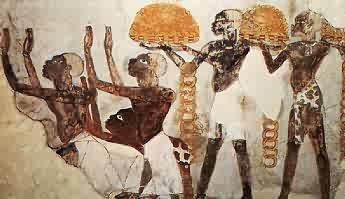
An Egyptian wall painting showing Black Nubians bringing gold offerings - showing how the White Egyptians depicted their Black neighbors 1850 BC.
"TO PREVENT THAT ANY BLACK SHOULD CROSS..."
The final conquest of Nubia was attained by Sesostris III in 1840 BC. This king conducted four campaigns against the Blacks and erected several forts at strategic points, making Nubia a permanent colony of Egypt.
The first Semneh stela inscription recounting the subjugation of Nubia by Sesostris III reads as follows:
"Southern boundary, made in the year 8, under the majesty of the king of Upper and Lower Egypt, Sesostris III, ... in order to prevent that any Black should cross it, by water or by land, with a ship, or any herds of the Blacks; except a Black who shall come to do trading in Iken, or with a commission. Every good thing shall be done with them but without allowing a ship of the Blacks to pass by Heh, going down stream, forever."
EGYPTIAN RACIAL WRITINGS: THE EIGHTEENTH DYNASTY (1580-1350 BC)
The inscription of Ahmose reads:
"Now after his majesty had slain the Asiatics, he ascended the river...to destroy the Nubian Troglodytes; his majesty made a great slaughter among them."
The Tombos Stela of Thutmose I reads:
"He hath overthrown the chief of the Nubians; the Black is helpless, defenseless, in his grasp. He hath united the boundaries of his two sides, there is not a remnant among the curly-haired, who came to attack; there is not a single survivor among them...They fall by the sword...the fragments cut from them are too much for the birds."
In the annals of the great warrior king, Thutmose III, at the sixth Karnak pylon, there is a list which contains no less than 115 of the names of the towns and districts of the conquered Nubian regions.
Another pylon at Karnak contains possibly four hundred towns, districts, and countries conquered in Nubia. Inscribed on a black granite tablet Karnak is the famous "Hymn of Victory" which reads as follows:
"I have bound together the Nubian Troglodytes by the tens of thousands. The northerners by hundreds of thousands as prisoners."
Another remarkable inscription is to be found on the Semmeh Stela of Amenhotep III, now to be found in the British Museum in London. It reads as follows:
"List of the captivity which his majesty took in the land of Ibbet the wretched."
List of Prisoners and Killed
Living Blacks 150 heads
Archers 110 heads
Female Blacks 250 heads
Servants of the Blacks 55 heads
Their children 175 heads
Total 740 heads
Hands thereof 312
United with the living heads 1,052 "
THE RED HAIRED RAMSES II - LAST SIGNIFICANT WHITE PHARAOH
Egypt's last display of national vigor came with the red haired Pharaoh Ramses II (1292 - 1225 BC). Ramses II managed to re-establish the already decaying Egyptian Empire by recapturing much land in Nubia.
He also fought a series of battles against invading Indo-Europeans, the Hittites. This was culminated with the battle of Kadesh in northern Syria. Ramses signed a treaty with the Hittites in 1258 BC, which ended the war. In terms of the treaty, Ramses took as his wife an Indo-European Hittite princess. His other achievements included the building of the rock-hewn temple of Abu Simbel, the great hall in the Temple of Amon at Karnak, and the mortuary temple at Thebes.
After this king, Egypt entered into a steady period of decay, caused directly by the elimination of the original Egyptians, and their replacement with a mixed population made up of Black, Semitic and the remnant White population. This racially widely divergent nation was never again to reach the heights achieved by the First, Second or the first part of the Third Kingdoms. In these later years there were competing claimants to the pharaohs throne, many of whom, racially speaking, bore no resemblance to the original pharaohs at all.
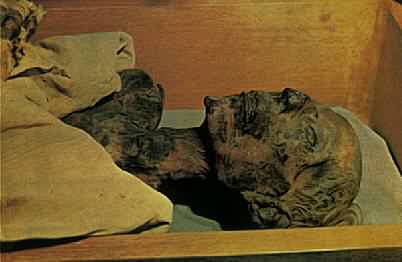
The mummy of the red haired Egyptian King, Ramses II, is on public display at the Egyptian Museum, Cairo.
MIXED RACE PHARAOH IS THE LAST PHARAOH
The true Egyptians had all vanished at the very latest by 800 BC, and the divided and weakened Egypt was easy prey to numerous invaders, some Semitic, some Nubian and some Indo-European, none of whom established any sort of permanent rule.
The most prominent Nubian invaders set up a new kingdom, claiming to be the inheritors of the previous kingdoms, called today the 25th dynasty. This 100 year dynasty saw a number of mixed race rulers from 730 BC to 633 BC, all claiming to be pharaohs and attempting to revive some of the older practices, such as mummification.
The Nonwhite "Egyptians" were however an illusion - the true White Egyptians had vanished, along with their society, and the Nubian dynasty sputtered out of its own accord. The last pharaoh of this Nubian dynasty, Taharka, whose mixed race ancestry is clear from sculptures, was driven from his throne by invading Assyrians, and it is from this fall of Taharka that historians formally date the fall of Egypt, although in reality the last true Egyptian had disappeared nearly two hundred years previously.
THE END OF ANCIENT EGYPT: OVERRUN BY THE BLACK NUBIANS
Left: the White Egyptian Pharaoh Tuthmosis III circa 1450 BC, and right, the Black Nubian Pharaoh Shabako, circa 710 BC. Above: The last White Egyptians had vanished prior to 800 BC, physically integrated into the mass of Nubian and Semitic peoples who had come to dominate that land. The resultant mixed race population was unable to withstand new invaders, some Semitic and some Black. The most prominent of the Black Nubian invaders then set themselves up as new Egyptian kings, later called the 25th Dynasty, dated from 746 - 655 BC. As can be seen from the racial features of the statue of Shabako, above right, the 25th dynasty was clearly Nonwhite. Compare Shabako's features to the unmistakably White visage of pharaoh Tuthmosis III (1490-1436 BC) left. Unable to maintain the originally White civilization they had inherited, the 25th Dynasty sputtered out of its own accord and was finally destroyed by an Assyrian invasion. Although the fall of Egypt is officially dated as from the end of the 25th Dynasty, in reality the true ancient Egyptians had vanished more than 200 years earlier. |
SKULLS - DETAILED STUDY REVEALS PAST
The course of racial developments in Egyptian history has been backed up by anthropological research. The British anthropologist G.M. Morant produced a comprehensive study of Egyptian skulls from commoner and royal graves from all parts of the Egyptian lands and times. His conclusions were that the majority of the population of Lower Egypt - that is in the Northern part of the country - were members of the (now virtually extinct) Mediterranean White subrace. In the south (or Upper Egypt) this population pattern was repeated but this time showing a certain percentage of Black admixture (reflecting the proximity of the Nubian settlement). Significantly, Morant found that with the passage of time, the differentiation in skull types between Upper and Lower Egypt became less and less distinct, until ultimately they became indistinguishable - the surest sign of the absorption of the White subrace into the growing Nonwhite mass. (Race, John R. Baker, Oxford University Press, 1974, page 519).
After passing under Ethiopian, Assyrian and Persian rule, Egypt was finally occupied in 325 BC by the Greek Macedonian Alexander the Great (whose tribe was one of the original Indo-European invaders of the Greek peninsula).
or back to
or
All material (c) copyright Ostara Publications, 1999.
Re-use for commercial purposes strictly forbidden.
CLICK HERE for the special section:
"WHITE EGYPT: REFUTING THE LIES BY BLACK SUPREMACISTS ABOUT THE WHITE ORIGINS OF ANCIENT EGYPT"
(It has a link back to this page and back to the White History main page)